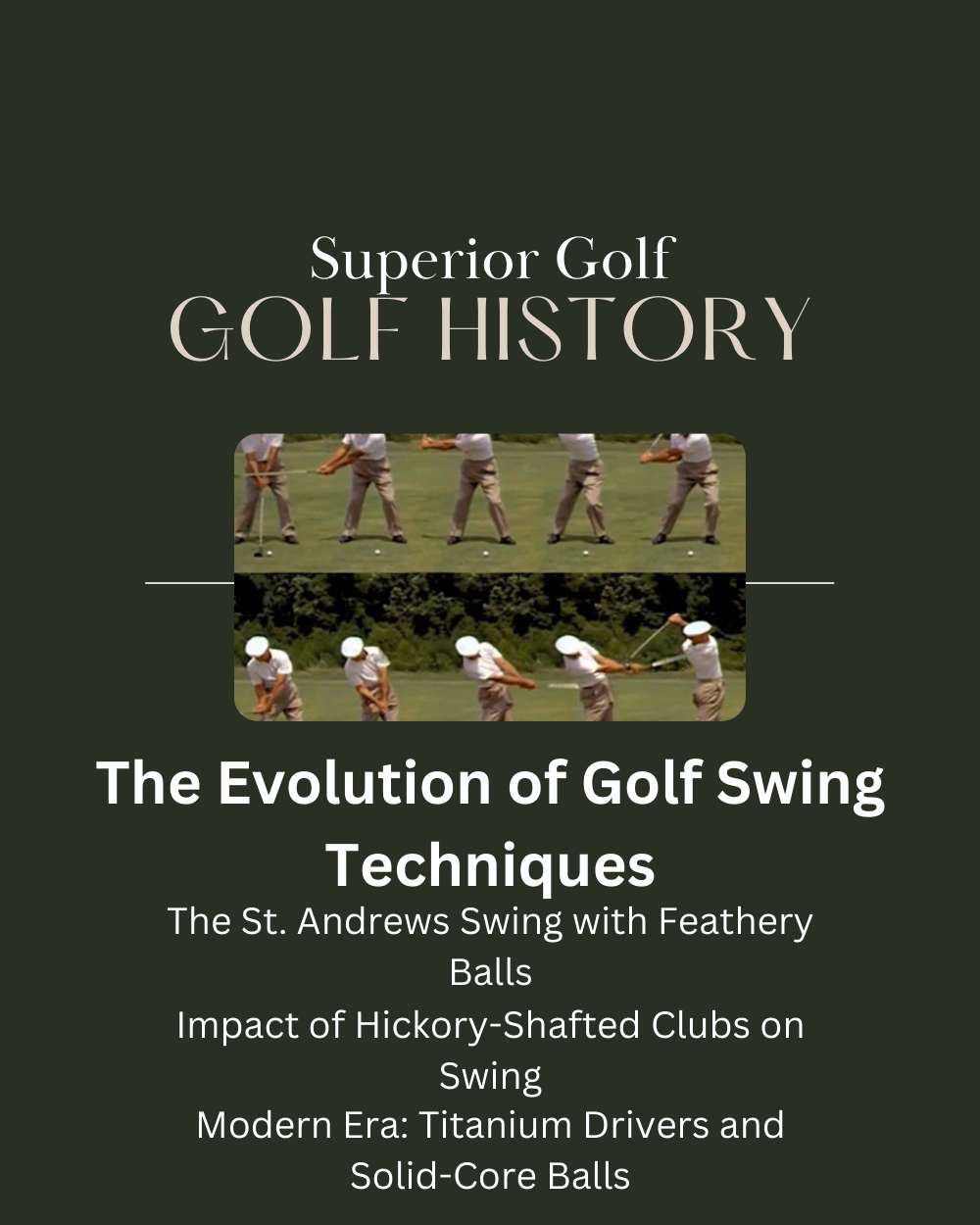The Evolution of Golf Swing Techniques: Golf swings have greatly changed over time. What once were rough, unguided motions are now the powerful, precise swings seen in tournaments. Golfers used to struggle with their swings, often trying to “scoop” or “chop” the ball. These methods didn’t work well.
Tom Abts teaches the importance of a smooth sweep for putting. He also suggests a different technique for using irons and drivers. This helps the ball to lift and sweep better. Thanks to new equipment, like modern golf balls and titanium drivers, swings have gotten a lot better1. These changes, along with tips from pros, help golfers improve their game.
The Evolution of Golf Swing Techniques Key Takeaways
- Understanding the evolution of golf swings can highlight the progression from basic motions to advanced techniques.
- Tom Abts advocates for a sweeping action in putting and a reversed approach for irons and drivers.
- Golfers historically struggled with ineffective natural inclinations like “scooping” and “chopping.”
- The transition from feathery to gutta-percha balls marked significant development in aerodynamics and swing techniques1.
- Modern advancements such as titanium drivers and solid-core balls influenced golfers to prioritize distance over accuracy1.
Historical Changes Influencing Swing Techniques
Golf’s swing techniques have evolved with equipment advances. Each era brought new changes, from the “St. Andrews swing” to today’s use of titanium drivers and solid-core balls.
The St. Andrews Swing with Feathery Balls
In golf’s early days, the feathery ball era, players used the “St. Andrews swing.” This swing helped manage the feathery balls’ need for a low flight. Golfers adapted by developing a sweeping motion to make the most out of these early balls.
Impact of Hickory-Shafted Clubs on Swing
The switch to hickory-shafted clubs introduced a new challenge. Hickory shaft influence meant golfers needed stronger hand actions. This was to manage the clubs’ torque and improve rotation, changing swing styles significantly.
Development with Gutta-Percha Balls
The introduction of gutta-percha balls brought new swing adjustments. Gutta-percha aerodynamics led to more upright swings. Golfers like Harry Vardon exemplified these changes to take advantage of the balls’ aerodynamic properties.
Revolution with Steel-Shafted Clubs
Steel-shafted clubs marked a significant turning point. Moving from hickory to steel changed players’ approach to swings. This transition meant shots could be more powerful and consistent.
Modern Era: Titanium Drivers and Solid-Core Balls
Today, titanium drivers and solid-core balls have refined swings even further. These advancements allow for unmatched precision and distance. Golfers have evolved their swings to take full advantage of these modern innovations.
| Era | Equipment Advances | Impact on Swing |
|---|---|---|
| Feathery Balls | Low, ground-hugging trajectory | St. Andrews swing |
| Hickory-Shafted Clubs | Torque requiring hand action | Effective rotation |
| Gutta-Percha Balls | Improved aerodynamics | Upright swings |
| Steel-Shafted Clubs | Consistent power and precision | Shift from hickory to steel |
| Titanium Drivers & Solid-Core Balls | Enhancing precision and distance | Refined modern swings |
Modern Golf Swing Techniques and Technological Impact
The way we swing in golf has really changed thanks to biomechanics. It helps us get how the body moves when we swing. Technology has made it easier to teach swings. This makes your game better and more consistent.
Advancements in Biomechanics
People using different golf swings vary in age, height, and weight. Those focusing on their lower body for swinging were about 54 years old, 183 cm tall, and weighed 92.5 kg. The modern swingers were younger, at 48 years, shorter at 176.8 cm, and lighter at 82.1 kg2. This study helps us get how to rotate and speed up your swing right2. Early research connects the type of swing to how muscles work. This reduces unneeded strain2.
Role of Technology in Swing Analysis and Improvement
Now, tech like video tracking and sensors help a lot in breaking down golf swings. Things like high-end clubs and swing gadgets give clear feedback. They point out usual errors, like swinging too hard3. Golf simulators and tools help players get better at swinging at the right time and keeping balanced3.
Comparing Swings of Past and Present: Weiskopf vs. Cantlay
Looking at famous swings shows how new methods stack up against old ones. Byron Nelson’s swing was known for its club staying on target because of his strong legs4. But, modern players like Patrick Cantlay lean on new science and tech to keep their swings even4. Whereas Weiskopf stuck to basics, current players use tech to make tiny, but important, changes4.
Tour Players’ Influence on Amateur Swings
Pros really shape how amateurs play, sharing top-level tips and tricks. They show the value of understanding your swing’s mechanics. They aim for a shoulder turn of up to 30 degrees by keeping their arm straight, even as they age5. Amateurs copy this, focusing on their hips and avoiding shifting their weight wrong5. By taking advice from the pros, including on gear and tech-aided practice, amateurs can really up their game5.
| Metrics | Lower Body Swings | Modern Swims |
|---|---|---|
| Age (years) | 53.9 (±12.1 SD) | 48.0 (±13.6 SD) |
| Height (cm) | 182.9 (±6.1 SD) | 176.8 (±4.4 SD) |
| Weight (kg) | 92.5 (±14.8 SD) | 82.1 (±5.3 SD) |
| Handicap | 15.8 (±6.3 SD) | 9.1 (±5.1 SD) |
Conclusion
The way golf swings have changed shows how the game keeps getting better. Golfers need to know key things like how to hold the club, stand, and move. This makes their swings accurate and strong. Pros like Sam Bennett and Steve Stricker6 show there’s more than one way to be great. Old swing methods have helped shape new ones. This also shows how new gear and old tricks work together.
In the beginning, golfers made do with simple clubs and balls. This made them swing in a low, smooth way. Now, tech tools like the “Lag Shot” and video help golfers fix their swings6. Getting help from a coach can really change a player’s game. Some saw their handicap drop by 30% in just three months7.
Studying how bodies move has made analyzing swings better. This helps players use less effort but move more smoothly. By focusing on how to stand and shift weight, some golfers now hit the ball a lot farther7. It’s also key to control the club at the lowest point of the swing. Mixing different swing styles, like those of Tiger Woods, Jim Furyk, and Rory McIlroy, leads to better play8.
So, better gear, teaching tools, and understanding body movements have made golfers improve. By using these new ideas, players of all levels can get better and really enjoy their game. It shows how closely linked are the gear we use and how we swing.
Q: How have modern technologies impacted golf swing instruction and player development?
How has the development of golf swing techniques evolved over time?
What was the significance of the “St. Andrews swing” in early golf?
How did the introduction of hickory-shafted clubs affect golfers’ swings?
What changes occurred in swing techniques with the advent of gutta-percha balls?
In what ways has the study of biomechanics contributed to modern golf swing techniques?
How do swings of past players like Tom Weiskopf compare to current golfers such as Patrick Cantlay?
What influence do tour players have on amateur golfers’ swing techniques?
Source Links
- https://www.usgtf.com/the-evolution-of-the-golf-swing-as-dictated-by-equipment/
- https://commons.nmu.edu/cgi/viewcontent.cgi?article=1730&context=isbs
- https://sandhollowresort.com/different-types-of-golf-swings-tips-for-how-to-swing-well
- https://www.pgatour.com/article/news/latest/2020/05/04/how-byron-nelson-developed-the-modern-golf-swing
- https://golf.com/instruction/state-of-the-art-technology-reveals-the-10-biggest-golf-swing-killers/
- https://skillest.com/blog/a-comprehensive-guide-to-mastering-the-golf-swing/
- https://ddsports.us/blogs/become-an-elite-golfer-like-the-pros/master-the-perfect-golf-swing-your-roadmap-to-success
- https://uneekor.com/blogs/blog/understanding-different-types-of-golf-swings

